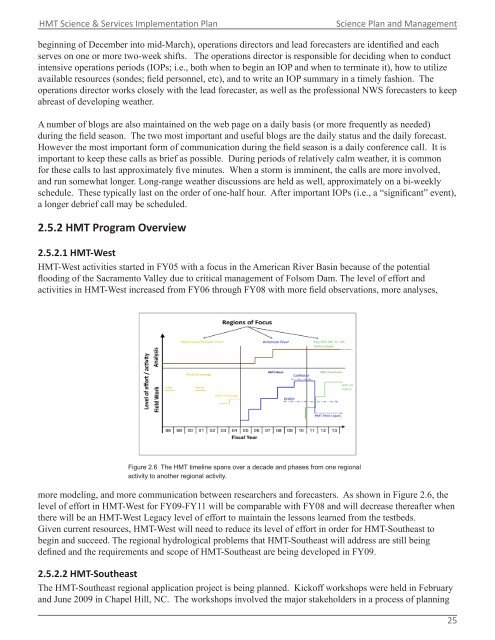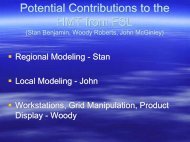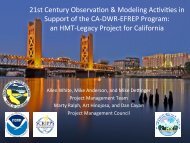Hydrometeorology Testbed (HMT) Program - NOAA ...
Hydrometeorology Testbed (HMT) Program - NOAA ...
Hydrometeorology Testbed (HMT) Program - NOAA ...
You also want an ePaper? Increase the reach of your titles
YUMPU automatically turns print PDFs into web optimized ePapers that Google loves.
<strong>HMT</strong> Science & Services Implementation Plan Science Plan and Management<br />
beginning of December into mid-March), operations directors and lead forecasters are identified and each<br />
serves on one or more two-week shifts. The operations director is responsible for deciding when to conduct<br />
intensive operations periods (IOPs; i.e., both when to begin an IOP and when to terminate it), how to utilize<br />
available resources (sondes; field personnel, etc), and to write an IOP summary in a timely fashion. The<br />
operations director works closely with the lead forecaster, as well as the professional NWS forecasters to keep<br />
abreast of developing weather.<br />
A number of blogs are also maintained on the web page on a daily basis (or more frequently as needed)<br />
during the field season. The two most important and useful blogs are the daily status and the daily forecast.<br />
However the most important form of communication during the field season is a daily conference call. It is<br />
important to keep these calls as brief as possible. During periods of relatively calm weather, it is common<br />
for these calls to last approximately five minutes. When a storm is imminent, the calls are more involved,<br />
and run somewhat longer. Long-range weather discussions are held as well, approximately on a bi-weekly<br />
schedule. These typically last on the order of one-half hour. After important IOPs (i.e., a “significant” event),<br />
a longer debrief call may be scheduled.<br />
2.5.2 <strong>HMT</strong> <strong>Program</strong> Overview<br />
2.5.2.1 <strong>HMT</strong>-West<br />
<strong>HMT</strong>-West activities started in FY05 with a focus in the American River Basin because of the potential<br />
flooding of the Sacramento Valley due to critical management of Folsom Dam. The level of effort and<br />
activities in <strong>HMT</strong>-West increased from FY06 through FY08 with more field observations, more analyses,<br />
Figure 2.6 The <strong>HMT</strong> timeline spans over a decade and phases from one regional<br />
activity to another regional activity.<br />
more modeling, and more communication between researchers and forecasters. As shown in Figure 2.6, the<br />
level of effort in <strong>HMT</strong>-West for FY09-FY11 will be comparable with FY08 and will decrease thereafter when<br />
there will be an <strong>HMT</strong>-West Legacy level of effort to maintain the lessons learned from the testbeds.<br />
Given current resources, <strong>HMT</strong>-West will need to reduce its level of effort in order for <strong>HMT</strong>-Southeast to<br />
begin and succeed. The regional hydrological problems that <strong>HMT</strong>-Southeast will address are still being<br />
defined and the requirements and scope of <strong>HMT</strong>-Southeast are being developed in FY09.<br />
2.5.2.2 <strong>HMT</strong>-Southeast<br />
The <strong>HMT</strong>-Southeast regional application project is being planned. Kickoff workshops were held in February<br />
and June 2009 in Chapel Hill, NC. The workshops involved the major stakeholders in a process of planning<br />
25






